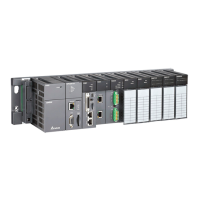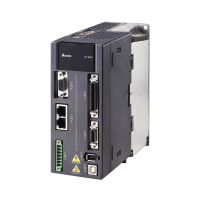Chapter 6 Applied Instructions
6-177
3. To prevent the parameters which have been tuned automatically from disappearing after a
power cut, users have to store the parameters in the latched data registers when is
PID_MODE set to 1. The parameters which have been tuned automatically are not
necessarily suitable for every controlled environment. Therefore, users can modify the
parameters which have been tuned automatically. However, it is suggested that users only
modify the K
I
or the K
D
.
4. The instruction should be used with many parameters. To prevent the improper control from
occurring, please do not set the parameters randomly.
Example 1: The use of the instruction PID in the position control (PID_MODE is set to 0 or 2.)
Position command (SV)
PID
MV
P
lant
Encoder
PV
Example 2: The instruction PID is used with the AC motor drives. (PID_MODE is set to 0 or 2.)
Speed command (S)
PID
S+MV
AC motor
drives
Speed
detector (P)
+
+
Acceleration/Deceleration
command (SV)
Acceleration/Deceleration
output (MV)
Actual acceleration/
deceleration
(PV=S-P)
Example 3: The use of the instruction PID in the temperature control (PID_MODE is set to 0 or 2.)
Temperature command (SV)
PID
Heating (MV)
Heater
Actual temperature (PV)
Temperature
detector
Example 4: The steps of tuning the parameters used with the instruction PID
Suppose that the transfer function of the plant is the first-order function
, the SV is 1, the
sampling time Ts is 10 milliseconds. It is suggested that the steps of tuning the parameters are as
follows.
Step 1: First, set the K
I
and the K
D
to 0. Next, set the K
P
to 5, 10, 20 and 40 successively, and record
the target values and the process values. The results are shown in the diagram below.

